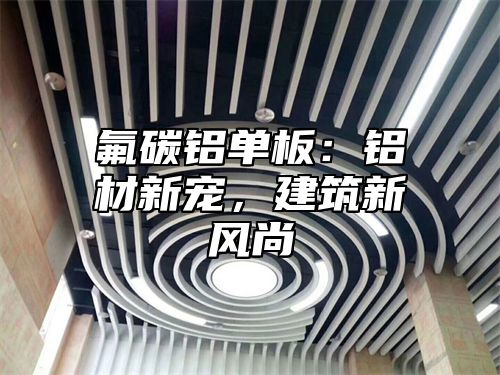

 Industry information
Industry information
Dear colleagues in the construction industry, today we will talk about a rising star in the construction industry - fluorocarbon aluminum veneer. You may not have heard of this name, but it is becoming increasingly popular in modern architecture. Let's talk about fluorocarbon aluminum veneer and see why it has become a new trend in architecture.
We need to talk about what fluorocarbon aluminum veneer is. It is a sheet made of aluminum through special processing techniques. It sounds ordinary, but don't underestimate this layer of treatment. It can make aluminum shine in color, texture, and weather resistance.
I first came into contact with fluorocarbon aluminum veneer at a friend's new home. The exterior of the house is decorated with this material, colorful and full of texture. I stood downstairs, stunned by its beauty. Can this building material still have such an artistic sense? Certainly.
The charm of fluorocarbon aluminum veneer is first reflected in its color. You can imagine that after being treated with fluorocarbon spraying technology, aluminum presents rich colors. From low-key gray to vibrant red and blue, and then to unique gold, it's like a color palette, allowing you to unleash your creativity. Isn't this the personalization pursued by modern architecture?
Speaking of texture, the coating on the surface of fluorocarbon aluminum veneer gives it excellent wear resistance and corrosion resistance. In the sunlight, it reflects a dazzling light, giving people a sense of nobility and elegance. And in the wind and rain, it remains as solid as a rock, durable and long-lasting. Isn't this the environmental protection and energy efficiency that modern architecture pursues?
When it comes to fluorocarbon aluminum veneer, its application fields cannot be ignored. It is widely used for exterior wall decoration of high-end office buildings, commercial complexes, residential communities, public facilities and other buildings. Believe it or not, some famous landmark buildings in China, such as the Shanghai World Financial Center and Guangzhou Tower, use fluorocarbon aluminum veneer.
What are the advantages of fluorocarbon aluminum veneer? Let me list a few advantages for you:
1. Strong weather resistance: Fluorocarbon aluminum veneer can maintain good performance in harsh weather conditions such as high temperature, high cold, acid rain, etc., and is not easily faded or peeled off.
2. Corrosion resistance: Fluorocarbon coatings have excellent corrosion resistance and can effectively resist the erosion of chemical substances such as acids, alkalis, and salts.
3. Easy to clean: The surface of fluorocarbon aluminum veneer is smooth and not easily stained, making cleaning very convenient.
4. Lightweight and beautiful: Fluorocarbon aluminum veneer is lightweight, easy to install, and has a variety of shapes, which can meet the needs of different architectural styles.
5. Energy saving and environmental protection: Fluorocarbon aluminum veneer has good thermal insulation performance, which helps reduce building energy consumption.
What should be noted during the construction process of fluorocarbon aluminum veneer?
1. Grassroots treatment: Ensure that the base is flat, dry, free of oil stains and debris.
2. Coating thickness: The thickness of fluorocarbon coating should be controlled at 30-40 microns to ensure its performance.
3. Construction environment: During the construction process, adverse factors such as direct sunlight and rainwater erosion should be avoided.
4. Pollution prevention: Effective measures should be taken during the construction process to prevent paint contamination.
5. Construction sequence: Apply primer first, then topcoat, and finally fluorocarbon coating.
Fluorocarbon aluminum veneer, as a new type of building material, has become the new favorite of modern architecture due to its excellent performance and beautiful appearance. I believe that in the near future, it will play an increasingly important role in the field of architecture.
I want to say that this fluorocarbon aluminum veneer is really eye-catching. I used to think that building materials were cold and lifeless, but I never expected that they could still have such individuality now. what you think? Hey guys, what do you think of the prospects of fluorocarbon aluminum veneer in the construction industry? Welcome to leave a message in the comment section for communication!